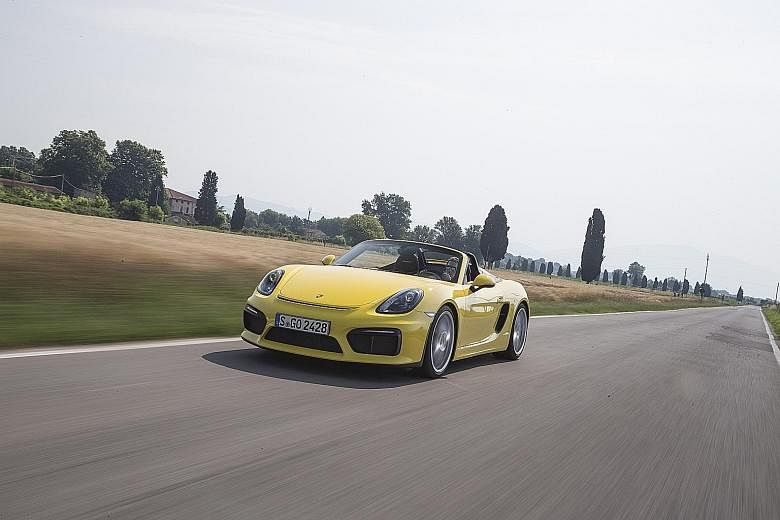It may cost nearly half a million dollars after COE and frills, but one could argue that Porsche's new Boxster Spyder is a bit of a bargain.
After all, you are getting most of what makes its hardcore stablemate the Cayman GT4 so special, at a discount of more than $40,000 - Porsche has shamelessly cannibalised the GT4 to create this, the most focused and potent Boxster of all.
The close relationship between the two cars is obvious at first glance, because the Spyder wears the GT4's entire front end.
This means a jutting, low- chinned front bumper dominated by three gaping intakes, and a horizontal, slit-like air vent at the leading edge of the bonnet, which visually sets the Spyder apart from the rest of the Boxster range.
Underneath, the Spyder's 3.8- litre flat-six powerplant is identical to that of the GT4 (which was nicked from the 911 Carrera S). But because the Spyder lacks the GT4's sideblades along its flanks which create a "ram-air" effect at high speed, it has 10bhp less, at 375bhp.
-
SPECS/ PORSCHE BOXSTER SPYDER
-
Price: $382,588 without COE
Engine: 3,800cc 24-valve flat-6
Transmission: Six-speed manual
Power: 375bhp at 6,700rpm
Torque: 420Nm at 4,750-6,000rpm
0-100kmh: 4.5 seconds
Top speed: 290kmh
Fuel consumption: 9.9 litres/100km
Agent: Stuttgart Auto
Still, this gives it a 45bhp advantage over the next most powerful Boxster model, the GTS.
Inside, the Spyder benefits from the GT4's smaller, alcantara- covered steering wheel and stubbier gear lever. It is billed as the Boxster for purists, so this new model is manual-only (there is no dual- clutch option). The gear throw is delightfully short and precise, and if you select Sport Plus mode, the engine automatically blips itself on downshifts to mimic a perfect heel-toe gear change.
In keeping with the Spyder's purist ethos, weight-saving is paramount, which explains measures such as the lightweight bucket seats and reduced sound insulation inside, and the use of aluminium for the rear deck.
Incidentally, that rear deck, which stretches from the aft of the cabin all the way to the ducktail spoiler, sports two pronounced bulges flowing rearwards from the roll hoops, and gives the car a unique, unmistakable silhouette. This harks back to the Spyder's inspiration - the 1953 550 Spyder, which had a similar longitudinal hump adorning its engine cover.
The folding top is now a lighter, semi-manual set-up. It looks markedly different from the standard Boxster's, being lower but with two distinctive "fins" stretching backwards into that raised rear deck. The rear window is polymer instead of glass, the hood frame is made of lightweight materials such as magnesium and aluminium, and the hood itself is now an unlined, single-layer affair.
Where the normal Boxster has a fully automated folding top, the Spyder's has to be raised and lowered by hand. The electric switches in the cabin now merely serve to unlatch the rear deck and to operate the header rail catch to secure the hood once it is in place.
This roof shaves 10kg off the car's weight and also helps lower its centre of gravity. Combined with all the other measures, this makes the Spyder the lightest model in the Boxster range, despite it having the biggest engine.
The payoff for all that weight loss is in the handling, of course.
The normal Boxster is already brilliant around bends, but the Spyder dials that up a notch, positively flicking into turns, allowing almost no lean at all, and delivering so much roadholding that on the twisty Tuscan mountain roads of our test route, my courage runs out way before the grip does.
The sensations through that small steering wheel are wonderful, relaying lots of detail about what the chassis is up to as the car hurtles along. The steering is ultra-responsive, and is quick-geared enough for sweepers to be taken with the slightest swivel of the wrist.
Between corners, the car is ferocious, belting forward with much more urge than the already rapid Boxster GTS. The extra power and torque of that 3.8-litre engine really do make themselves felt right across the rev range. The century sprint is covered in just 4.5 seconds and top speed is a sky-high 290kmh.
That engine makes itself heard too, howling its way thrillingly through the midrange to its 7,600rpm redline, and crackling like a mouthful of popping candy when you lift off. If sensory overload is your thing, drive the Spyder flat-out through a tunnel with the top down.
The car does not just devour B-roads, it has proven its mettle on the track too. Its lap time at the Nurburgring is 7 minutes 47 seconds, a mere 7 seconds behind the GT4's benchmark.
It may be the hardest-edged, fastest Boxster, but the Spyder still retains most of the base model's friendly usability. Add the seductiveness of that low-roofed, evocative shape and you can see why many will be snared in the Spyder's web.
• The writer is a regular contributor to Torque, a motoring monthly published by SPH Magazines.

